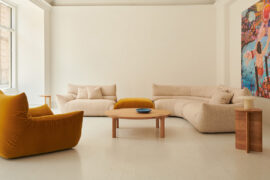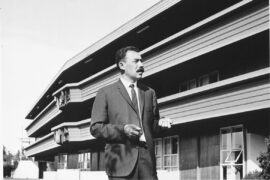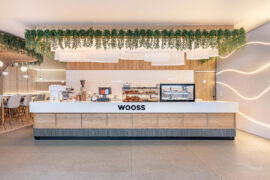Ahead of his time in sustainability research and an icon in Australian mid-century design, we honour Derek Wrigley’s extraordinary life and his significant contribution to the fabric of Australian design and architecture.

Photography by Stuart Hay.
August 26th, 2021
Revered as a forerunner of Australian 20th century design, we celebrate Derek Wrigley’s life and his significant contribution to the fabric of Australian design.
Across Australia, but particularly at the Australian National University, Wrigley’s designs are so ubiquitous – at ANU in the form of the university crest and the school’s typeface, furniture, sculpture, buildings and lecture theatre seating – that they appear hidden in plain sight. This is also evident publicly, with Wrigley’s designs popping up in the High Court of Australia’s Coat of Arms in courts two and three, and street furniture around Canberra.

Wrigley’s OB2 House.
A jack of all trades, simply calling Wrigley a designer may fall short of encompassing the entirety of his skills. Wrigley was an architect, teacher, author, photographer, sculptor, inventor, innovator, and much more.
After failing his high school certificate and completing just a few months as an apprentice at an electrical manufacturing firm in Manchester, Wrigley went on to gain entry to Architecture at Manchester College of Art by submitting a measured drawing of his own bicycle that he completed at age 16. In 1945, Wrigley’s outstanding results gained him top place in the all-England architectural exams.
Two years later, Wrigley emigrated to Australia where he purchased an abandoned quarry in Dee Why, NSW for £100, and got to work building a house, OB1. Over his life, Wrigley amassed five self-designed OB houses.

Wrigley’s 1956 plans for OB2.
“My lifelong search for simplicity without unnecessary stylism has always been expressed in my designs – no doubt influenced by my early Bauhaus style architectural training at Manchester in the 1940s. The sharpening of my aesthetic senses really took off after my arrival in Australia at the end of 1947,” said Wrigley.

Trial furniture for OB1 house, 1949.
In 1953, Derek Wrigley became a founding member of the NSW Chapter of the Society for Designers for Industry, which subsequently became the Industrial Design Institute of Australia and eventually the Design Institute of Australia.
“Architecture became my springboard into design and has served me well as a core discipline applicable to a growing number of peripheral design areas’, said Derek Wrigley.
Wrigley was an imperative factor in developing the Australian design community, and as such he founded the Industrial Design College of Australian in 1956. His influence at The Australian National University, which he joined in ‘57, saw the design unit grow to include landscape, graphics, furniture, building and industrial design. During his 20 years at ANU, he developed state of the art lecture theatre seating, the university’s typeface, buildings and sculptures, and much more.

Conference seating in the Academy of Science.
In the late 70s, Wrigley left ANU to pursue solar research. This research led him to experiment on his own homes with solar passive concepts. In the 90s, Wrigley began retrofitting his own property with an array of concepts to save power, including early examples of double glazing and solar panels. His research was later published in his first book, Making Your Home Sustainable: A Guide to Retrofitting.

“The coffee table was one of my moments of relaxation into furniture making – out of necessity because it was impossible to buy good modern furniture in the shops. The hairpin legs were avante garde elements of the day but I justified this rare lapse into fashion on the grounds that they did not restrict the view,” wrote Derek Wrigley.
Wrigley was a passionate designer who continued working his whole life, believing designers never truly retired because they were having too much fun.
“Design is a ubiquitous, positive, fundamental human force for the betterment of everything on our planet – natural or human-induced,” said Wrigley.
INDESIGN is on instagram
Follow @indesignlive
A searchable and comprehensive guide for specifying leading products and their suppliers
Keep up to date with the latest and greatest from our industry BFF's!

A curated exhibition in Frederiksstaden captures the spirit of Australian design

Welcomed to the Australian design scene in 2024, Kokuyo is set to redefine collaboration, bringing its unique blend of colour and function to individuals and corporations, designed to be used Any Way!

London-based design duo Raw Edges have joined forces with Established & Sons and Tongue & Groove to introduce Wall to Wall – a hand-stained, “living collection” that transforms parquet flooring into a canvas of colour, pattern, and possibility.
The internet never sleeps! Here's the stuff you might have missed

A retrospective at Canberra Museum + Gallery honours Enrico Taglietti, shaping the exhibition through his own design principles.

Sub-Zero Wolf Kitchen Design Contest (KDC) announces the remarkable Arizona Biltmore as the location of the 2026 Gala Venue and Winners’ Summit

Serving up the perfect dessert is about more than what’s in the crockery, it is also about cultivating an ambient, immersive setting that enhances the treats.